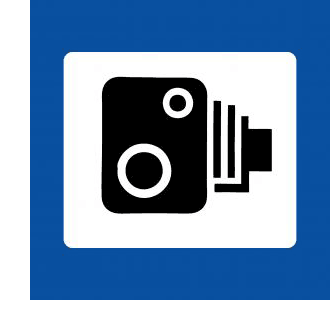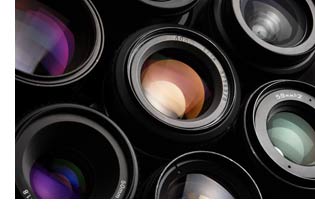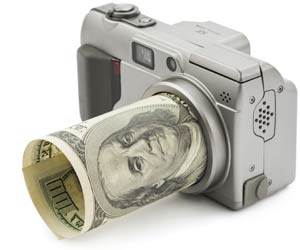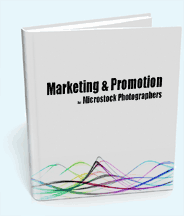 Lusting over the latest camera will earn you nothing from a micro-stock agency. There is no ideal or best camera, if there were everyone would buy that camera and all the other manufactures would be out of business. A good camera won't turn you into a great stock photographer, but microstock has a nasty habit of penalising even those who can take great photos if the technical quality of their camera is not up to scratch. The goal posts are constantly moving, what was acceptable five years ago will now fail the review process of most microstock sites as the standard of images constantly increases.
Lusting over the latest camera will earn you nothing from a micro-stock agency. There is no ideal or best camera, if there were everyone would buy that camera and all the other manufactures would be out of business. A good camera won't turn you into a great stock photographer, but microstock has a nasty habit of penalising even those who can take great photos if the technical quality of their camera is not up to scratch. The goal posts are constantly moving, what was acceptable five years ago will now fail the review process of most microstock sites as the standard of images constantly increases.
You should always try out a camera before you buy it and consider the size with whatever accessories you need to use not just the image specifications and price! Some cameras are too large and inflexible to shoot certain subjects, conversely compact cameras are very limiting if used for studio or portrait work.
Most serious microstock contributors and professional photographers shoot with more than one type of camera depending on the situation and the style of image they are capturing.
I have always assumed that visitors to this site have at least a passing interest in photography and already own a camera of some type; and are aware of the limitations or benefits of various cameras and lenses. Here's some advice for those in need of some direction.
Ideally an (D)SLR?
 Yes, but not always, there are three important aspects to successful stock photography income:
Yes, but not always, there are three important aspects to successful stock photography income:
1) Creativity and Ideas (that's up to you and you need a camera that won't make you limit your creativity)
2) Technical Excellence (a good camera will make things easier here that's for sure)
3) Marketing (for the beginner, leave this to the microstock agencies)
So, having a flashy, high resolution, low noise DSLR and some knowledge about how you use it will definitely make things easier when it comes to technicalities and having images accepted for sale; but alone it will not make you into a good photographer or make images that sell. The flip side is that even if you take a perfectly executed stock photo with a technically flawed camera then no agency will sell it for you.
"An SLR has significant benefits but it's not an absolute necessity"
That said, most serious microstock contributors shoot with a DSLR of one type or another, but the fact you don't own one should not in any way stop you from submitting images that will make sales. Depending on the camera you do have might be limited from taking certain types of shots, and you might be facing an uphill struggle having your photos accepted.
Specification for a 'Microstock Camera'
Amongst other things, if buying a camera for microstock you should pay close attention to:
Low Noise. If a point and shoot is reviewed as being 'average noise for its class' then it will probably fail the very stringent image inspectors who don't tolerate any noise (grain) in uploaded images. CMOS sensors usually produce less noise than CCD sensors. A good quality DSLR on its lowest ISO setting should have no problems.
Raw Mode: a distinct advantage, allowing you to modify colour balance and fine tune exposure without degrading image quality. all modern DSLRs support RAW images, and many of the high end compact cameras also support it. You can still shoot in jpeg at first but be aware that it will limit image use further down the line.
8 Megapixels or More: Megapixels are to some extent a myth, more megapixels does not always mean better quality, but having eight or more allows you to downsize images hence improving quality while still being over the 4 megapixel image requirements (minimum for some agencies) higher resolutions also sell for more money.
Distortion Free Macro: if you plan to do table top photography / still life work.
Is my "Point and Shoot" suitable?
 Perhaps, give it a go if you already have one, I frequently submit images from and 8MP digital point and shoot. Some of my best sellers even today were taken with a 2.1MP Coolpix years ago (I hasten to add that won't work with today's increased microstock standards!). You need to know the limitations of your camera, for me, night photography is out due to noise, macro images are often rejected as are telephoto images due to inadequacies of the lens. So why do I do it? Because I can take that camera everywhere, and even if I curse that I don't have my better quality cameras with me at least I can take a photo. If I go out to take photos for microstock then I would always choose the DSLR above a point and shoot.
Perhaps, give it a go if you already have one, I frequently submit images from and 8MP digital point and shoot. Some of my best sellers even today were taken with a 2.1MP Coolpix years ago (I hasten to add that won't work with today's increased microstock standards!). You need to know the limitations of your camera, for me, night photography is out due to noise, macro images are often rejected as are telephoto images due to inadequacies of the lens. So why do I do it? Because I can take that camera everywhere, and even if I curse that I don't have my better quality cameras with me at least I can take a photo. If I go out to take photos for microstock then I would always choose the DSLR above a point and shoot.
Do be aware that you will be more likely to get image rejections for technical reasons such as lens artefacts, distortions, noise, etc. If you are just starting out then it is a good way of finding out if the style or subjects of your images will be accepted and make good sales. Tip: One option is to scale down images from consumer quality cameras to reduce noise and artefacts, not an ideal solution but it does work - but I don't recommend it as part of a normal workflow, it's an option if you have a catalogue of good images from such a camera.
There are compact digital cameras that advertise themselves and DSLR quality these are the type of cameras to look for. You may also come across high end compact digital cameras which offer a fixed lens (no zoom), this might at first seem like a disadvantage but the images from these 'prime lens' cameras often indistinguishable to that from the average DSLR and kit lens. Don't be pushed into getting a clunky full size camera if you are not happy with that idea of using it.
There are compact cameras which take good quality images, but you often pay for their compact size, and they have some limitations (these days not that many considering the convenience they also offer). An entry level DSLR can often work out as a cheaper option if you don't mind the bulk.
Camera Phone?
No. True that some agencies accept phone images, perhaps as a way of getting editorial / news images in to the collection more easily. It's also true that mobile phone photography has been become a new umbrella term for 'from the hip', / lomo / instamatic / grunge niches. You can take the same images (i.e. discretely, small camera, in a place where a DSLR is not acceptable) with far higher quality and more easily using even the lowest end point and shoot camera.
Can I Shoot Film?
You can, but the film stock must be very low noise slide film like Fuji Velvia, and with the cost of a scanner somewhere around the cost of an entry level DSLR it means that few photographers shoot their microstock on film; if you are planning on purchasing a camera for microstock today then you would be mad to go for a film camera.
An advantage of film is that the image quality is the same from a quality compact 35mm camera as that of a 35mm SLR, and the cost of second hand film cameras is an absolute bargain these days. Film is very much a niche area of photography these days and only comes into its own for remote travel, large print panoramic and other specialist applications. istockphoto is the only agency to have a special review process for film scans, on the rest of the agencies your images are mixed in with those from digital cameras which tend appear sharper at 100% compared to an unsharpened film scan.
Can I Scan prints?
It's unlikely that the quality will be sufficient for today's strict microstock standards, you could try scanning the negatives, but unlike professional slide film there would likely be a lot of noise (this does depend on the film type and grade used).
Do I need a Camera?
Actually no you don't, there are many microstock contributors who have found a niche in creating 3d illustrations and vector artworks. Microstock video is also a growing sector if you own a good quality video camera (preferably one that shoots HD).
The best camera for microstock is the one that you are actually taking pictures with. It's useless having a DSLR if you are not happy taking it out with you 'because it's too big' or 'it was too expensive and i don't want to damage it'; you should take your camera everywhere. Before spending a lot of money do plenty of research, read reviews and ask for opinions and advice from other microstock photographers.
What Cameras do other microstock photograhers use?
Here's an infographic from stockphotosecrets




point shoot
hkki (not verified) on Sun, 2009-05-03 19:41Well, is about what you
about pics (not verified) on Thu, 2009-05-21 22:34camera does matter
AlfPC (not verified) on Sat, 2010-02-27 11:25I did once wonder about the
Steve Gibson on Mon, 2010-03-01 00:03I did once wonder about the metadata thing - but it would be quite easy to download one of the samples from a high end Nikon camera then cut and paste your photo into in, hence 'fake' having an expensive camera. you can also strip all that metadata out completely by cutting and pasting into a new image.
The better the camera the wider the range and/or the easier it becomes to get shots that are acceptable, what im saying (at least when I wrote this post originally) is that is not an absolute must to have a high end camera. - that said I think it gets harder all the time, and I now no no longer submit anything from even the G7 due to such high rejection - I can see the difference in quality, and so can the reviewers.
I read yuri gets images rejected for being 'too sharp', I forget the exact details of that but I think it was a 35MP medium format back that cost a fortune at the time.